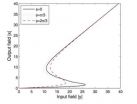(Press-News.org) In a study that included long-term follow-up of obese patients with type 2 diabetes, bariatric surgery was associated with more frequent diabetes remission and fewer complications than patients who received usual care, according to a study in the June 11 issue of JAMA, a diabetes theme issue.
Obesity and diabetes have reached epidemic proportions and constitute major health and economic burdens. Worldwide, 347 million adults are estimated to live with diabetes and half of them are undiagnosed.
Studies show that type 2 diabetes is preventable. The incidence of diabetes can be reduced by as much as 50 percent by lifestyle and pharmacological interventions, according to background information in the article.
Unique study on long-term outcome
Short-term studies show that bariatric surgery results in remission of diabetes. The long-term outcomes for bariatric surgery and diabetes remission and diabetes-related complications have not been known.
Lars Sjostrom, M.D., Ph.D., of the University of Gothenburg, Sweden, and colleagues performed a follow-up of the Swedish Obese Subjects (SOS) study, conducted at 25 surgical departments and 480 primary health care centers in Sweden. Of patients recruited between September 1987 and January 2001, 260 of 2,037 control patients and 343 of 2,010 bariatric surgery patients had type 2 diabetes at baseline.
Remission in 7 out of 10
For the current analysis, the presence of diabetes was determined at SOS health examinations and information on diabetes complications was obtained from national health registers. For diabetes complications, the median follow-up time was 17.6 years in the control group, and 18.1 years in the surgery group.
The proportion of patients in remission (defined as blood glucose END
Long-term follow-up after bariatric surgery shows greater rate of diabetes remission
2014-06-19
ELSE PRESS RELEASES FROM THIS DATE:
New cocaine tracking system could lead to better drug enforcement
2014-06-19
Law enforcement authorities need to better understand trafficking patterns of cocaine in the United States to address one of the world's largest illegal drug markets, according to a Michigan State University researcher whose new methodology might help.
Siddharth Chandra, an economist, studied wholesale powdered cocaine prices in 112 cities to identify city-to-city links for the transit of the drug. He used data published by the National Drug Intelligence Center of the U.S. Department of Justice from 2002 to 2011, which field intelligence officers and local, regional and ...
In hairless man, arthritis drug spurs hair growth -- lots
2014-06-19
A man with almost no hair on his body has grown a full head of it after a novel treatment by doctors at Yale University.
There is currently no cure or long-term treatment for alopecia universalis, the disease that left the 25-year-old patient bare of hair. This is the first reported case of a successful targeted treatment for the rare, highly visible disease.
The patient has also grown eyebrows and eyelashes, as well as facial, armpit, and other hair, which he lacked at the time he sought help.
"The results are exactly what we hoped for," said Brett A. King, M.D., ...
Stem cell mobilization therapy may effectively treat osteoarthritis
2014-06-19
Putnam Valley, NY. (June 19, 2014) – Researchers in Taiwan have found that peripheral blood stem cells can be "mobilized" by injection of a special preparation of granulocyte colony-stimulating factor (G-CSF) into rats that modeled osteoarthritis (OA). The bone marrow was stimulated to produce stem cells, leading to the inhibition of OA progression. The finding, they said, may lead to a more effective therapy for OA, a common joint disease that affects 10 percent of Americans over the age of 60.
The study will be published in a future issue of Cell Transplantation and ...
New digital fabrication technique creates interlocking 3D-printed ceramic PolyBricks
2014-06-19
New Rochelle, NY, June 19, 2014—An innovative system using automated 3D printing technology and advanced digital tools to create customized, prefabricated ceramic building blocks, called PolyBricks, is enabling the construction of mortar-less brick building assemblies at much greater scales than was previously possible. The new techniques that use 3D printers to produce modular ceramic bricks from a single material that then interlock and assemble easily into larger units for architectural applications are described in an article in 3D Printing and Additive Manufacturing ...
Haters spend more time…hating?
2014-06-19
PHILADELPHIA (June 19, 2014) – We already know haters are predisposed to be that way. Now we see they also spend a lot of time at fewer activities than their non-hater counterparts.
But in a twist of irony, that grumpy person at work may actually be pretty good at their job since they spend so much time on fewer activities, thereby giving them the opportunity to hone their skills in specific tasks.
It's all covered in a new study published in the journal Social Psychology. It seems that a person's "dispositional attitude" – whether the person is a "hater" or a "liker" ...
Criminal profiling technique targets killer diseases
2014-06-19
A mathematical tool used by the Metropolitan Police and FBI has been adapted by researchers at Queen Mary University of London to help control outbreaks of malaria, and has the potential to target other infectious diseases.
In cases of serial crime such as murder or rape, police typically have too many suspects to consider, for example, the Yorkshire Ripper investigation in the UK generated a total of 268,000 names. To help prioritise these investigations, police forces around the world use a technique called geographic profiling, which uses the spatial locations of ...
Humans have been changing Chinese environment for 3,000 years
2014-06-19
For thousands of years, Mother Nature has taken the blame for tremendous human suffering caused by massive flooding along the Yellow River, long known in China as the "River of Sorrow" and "Scourge of the Sons of Han."
Now, new research from Washington University in St. Louis links the river's increasingly deadly floods to a widespread pattern of human-caused environmental degradation and related flood-mitigation efforts that began changing the river's natural flow nearly 3,000 years ago.
"Human intervention in the Chinese environment is relatively massive, remarkably ...
Study: Controllable optical steady behavior obtainable from nonradiation coherence
2014-06-19
A new proposed scheme, by Wen-Xing Yang, from the Department of Physics, Southeast University, China, and colleagues, analyzed in detail the optical steady behavior in GaAs quantum well structure driven by an elliptically polarized field (EPF) in a unidirectional ring cavity.
They show that the controllable optical steady behavior including multi-stability (OM) and optical bistability (OB) can be obtained via nonradiation coherence, and the frequency detuning, cooperation parameter and the amplitude of the EPF. Most interestingly, the conversion between OB and OM can ...
Iconic Minnesota conifers may give way to a more broad-leafed forest in the next century
2014-06-19
Houghton, Mich., June 19, 2014: Over the next 100 years, Minnesota's iconic boreal forest and deep snow may change into a deciduous forest with winters warm enough for some precipitation to fall as rain, according to a new U.S. Forest Service assessment of the vulnerability of Minnesota forests to climate change.
"Minnesota Forest Ecosystem Vulnerability Assessment and Synthesis" was published by the U.S. Forest Service's Northern Research Station and is available online at: http://www.nrs.fs.fed.us/pubs/45939
The assessment describes effects of climate change that ...
The sweetest calculator in the world
2014-06-19
Jena (Germany) In a chemistry lab at the Friedrich Schiller University Jena (Germany): Prof. Dr. Alexander Schiller works at a rectangular plastic board with 384 small wells. The chemist carefully pipets some drops of sugar solution into a row of the tiny reaction vessels. As soon as the fluid has mixed with the contents of the vessels, fluorescence starts in some of the wells. What the Junior Professor for Photonic Materials does here – with his own hands – could also be called in a very simplified way, the 'sweetest computer in the world'. The reason: the sugar molecules ...





